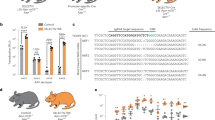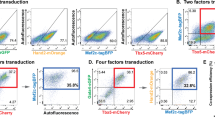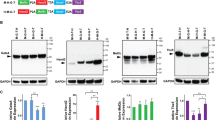Abstract
Leukocyte tyrosine kinase (LTK) is a receptor-type protein tyrosine kinase belonging to the insulin receptor superfamily. To elucidate its biological role, we generated transgenic mice expressing LTK under the control of cytomegarovirus enhancer and β-actin promoter. The transgenic mice exhibited growth retardation and most of the transgenic mice died within several months after birth. Interestingly, although LTK was expressed in several major organs, the activation (tyrosine-phosphorylation, kinase activity, and multimerization) of LTK was observed selectively in the heart, where LTK was localized on intracellular membrane, presumably on endoplasmic reticulum. Echocardiography showed that the transgenic heart underwent severe concentric hypertrophy, which resulted in reduced cardiac output, low blood pressure, and increased heart rate. Histological examination of the heart exhibited focal degeneration of cardiomyocytes. These histological changes were considered to be due to apoptosis, based on the finding that the sarcolemmas of the degenerative cardiomyocytes were well preserved. In addition, expression of fetal genes, such as atrial natriuretic peptide and skeletal α-actin, was markedly induced in the transgenic heart. These results indicate that a certain tissue-specific mechanism of activating LTK exists in the heart and that the activated LTK resulted in cardiac hypertrophy, cardiomyocyte degeneration and gene reprogramming. These findings will provide novel insights into the activating mechanism and biological role of LTK in vivo.
This is a preview of subscription content, access via your institution
Access options
Subscribe to this journal
Receive 50 print issues and online access
$259.00 per year
only $5.18 per issue
Buy this article
- Purchase on Springer Link
- Instant access to full article PDF
Prices may be subject to local taxes which are calculated during checkout








Similar content being viewed by others
References
Ben-Neriah Y and Bauskin AR. . 1988 Nature 333: 672–676.
Bernards A and de la Monte SM. . 1990 EMBO J. 9: 2279–2287.
Braskin AR, Alkalay I and Ben-Neriah Y. . 1991 Cell 66: 685–696.
Clarke PGH. . 1990 Anat. Embryol. 181: 195–213.
Conti FG, Powell R, Pozzi L, Zezze G, Faraggiana T, Gannon F and Fabbrini A. . 1995 Growth Reg. 5: 101–108.
Edwards JG, Lyons GE, Micales BK, Malhotra A, Factor S and Leinwand LA. . 1996 Circ. Res. 78: 379–387.
Furuta Y, Aizawa S, Suda Y, Ikawa Y, Nakasgoshi H, Nishina Y and Ishii S. . 1993 Transgenic Res. 2: 199–207.
Hanahan D. . 1988 Ann. Rev. Genet. 22: 479–519.
Hassankhani A, Steinhelper ME, Soonpaa MH, Katz EB, Taylor DA, Andrade-Rozental A, Factor SM, Steinberg JJ, Field LJ and Federoff HJ. . 1995 Dev. Biol. 169: 309–321.
Hasse VH, Snijders AJ, Cooke SM, Teng MN, Kaul D, Le Beau MM, Bruns GA and Bernards A. . 1991 Oncogene 6: 2319–2325.
Hasse VH, Wang TC, Schmidt EV and Bernards A. . 1995 Transgenics 1: 487–495.
Hayashi T, James TN and Buckingham DC. . 1995 Am. Heart J. 129: 946–959.
Herren B, Rooney B, Weyer KA, Iberg N, Schmid G and Pech M. . 1993 J. Biol. Chem. 268: 15088–15095.
Hirota H, Yoshida K, Kishimoto T and Taga T. . 1995 Proc. Natl Acad. Sci. USA 92: 4862–4866.
Hockenbery DM, Oltvai ZN, Yin XM, Milliman C and Korsmeyer SJ. . 1993 Cell 75: 241–251.
Honda H, Fujii T, Takatoku M, Mano H, Witte ON, Yazaki Y and Hirai H. . 1995 Blood 85: 2853–2861.
Hunter JJ, Tanaka N, Rockman HA, Ross Jr J and Chien KR. . 1995 J. Biol. Chem. 270: 23173–23178.
James TN, Terasaki F, Pavlovich ER and Vikhert AM. . 1993 J. Lab. Clin. Med. 122: 309–323.
Kane DJ, Sarafian TA, Anton R, Hahn H, Gralla EB, Valentine JS, Ord T and Bredesen DE. . 1993 Science 262: 1274–1277.
Komuro I, Kaida T, Shibasaki Y, Kurabayashi M, Katoh Y, Hoh E, Takaku F and Yazaki Y. . 1990 J. Biol. Chem. 265: 3595–3598.
Komuro I and Yazaki Y. . 1993 Ann. Rev. Physiol. 55: 55–75.
Kozutsumi H, Toyoshima H, Hagiwara K, Furuya A, Mioh H, Hanai N, Yazaki Y and Hirai H. . 1993 Biochem. Biophys. Res. Commun. 190: 674–679.
Kozutsumi H, Toyoshima H, Hagiwara K, Yazaki Y and Hirai H. . 1994 Oncogene 9: 2991–2998.
Krolewski JJ and Dalla-Farvera R. . 1991 EMBO J. 10: 2911–2919.
Kubota T, McTiernan CF, Frye CS, Slawson SE, Lemster BH, Koretsky AP, Demetris AJ and Feldman AM. . 1997 Circ. Res. 81: 627–635.
Maru Y, Hirai H and Takaku F. . 1990 Oncogene Res. 5: 199–204.
Morris SW, Naeve C, Mathew P, James PL, Kirstein MN, Cui X and Witte DP. . 1997 Oncogene 14: 2175–2188.
Morrison DK, Kaplan DR, Rhee SG and Williams LT. . 1990 Mol. Cell. Biol. 10: 2359–2366.
Niwa H, Yamamura K and Miyazaki J. . 1991 Gene 108: 193–200.
Ozawa M, Ringwald M and Kemler R. . 1990 Proc. Natl. Acad. Sci. USA 87: 4246–4250.
Sakai R, Iwamatsu A, Hirano N, Ogawa S, Tanaka T, Mano H, Yazaki Y and Hirai H. . 1994 EMBO J. 13: 3748–3756.
Schwartz K, de la Bastie D, Bouveret P, Oliviero P, Alonso S and Buckingham M. . 1986 Circ. Res. 5: 551–555.
Snijders AJ, Hasse VH and Bernard A. . 1993 Oncogene 8: 27–35.
Toyoshima H, Kozutsumi H, Maru Y, Hagiwara K, Furuya A, Mioh H, Hanai N, Takaku F, Yazaki Y and Hirai H. . 1993 Proc. Natl. Acad. Sci. USA 90: 5404–5408.
Tsujimoto Y, Finger LR, Yunis J, Nowell PC and Croce CM. . 1984 Science 226: 1097–1099.
Ueno H, Hirano N, Kozutsumi H, Sasaki K, Tanaka T, Yazaki Y and Hirai H. . 1995 J. Biol.Chem. 270: 20135–20142.
Ueno H, Sasaki K, Kozutsumi H, Miyagawa K, Mitani K, Yazaki Y and Hirai H. . 1996 J. Biol. Chem. 271: 27707–27714.
Yee SP, Mock D, Maltby V, Silver M, Rossant J, Bernstein A and Pawson T. . 1989 Proc. Natl. Acad. Sci. USA 86: 5873–5877.
Acknowledgements
We thank Dr Jun-ichi Miyazaki for pUCCAGGS expression vector and thank Dr Yoshihide Tsujimoto for anti-bcl-2 antibody. We also thank Nobuyoshi Machiyama for photographs. This work was in parts supported by Grants-in-Aids from the Ministry of Education, Science and Culture of Japan and Mochida Memorial Foundation For Medical and Pharmaceutical Research.
Author information
Authors and Affiliations
Rights and permissions
About this article
Cite this article
Honda, H., Harada, K., Komuro, I. et al. Heart-specific activation of LTK results in cardiac hypertrophy, cardiomyocyte degeneration and gene reprogramming in transgenic mice. Oncogene 18, 3821–3830 (1999). https://doi.org/10.1038/sj.onc.1202736
Received:
Revised:
Accepted:
Published:
Issue Date:
DOI: https://doi.org/10.1038/sj.onc.1202736
Keywords
This article is cited by
-
Genome-wide matching of genes to cellular roles using guilt-by-association models derived from single sample analysis
BMC Research Notes (2012)
-
Cardiotoxicity of kinase inhibitors: the prediction and translation of preclinical models to clinical outcomes
Nature Reviews Drug Discovery (2011)
-
Apoptosis and oncosis in acute coronary syndromes: Assessment and implications
Molecular and Cellular Biochemistry (2005)
-
Inhibition of fast sodium current in rabbit ventricular myocytes by protein tyrosine kinase inhibitors
Pflügers Archiv - European Journal of Physiology (2003)



